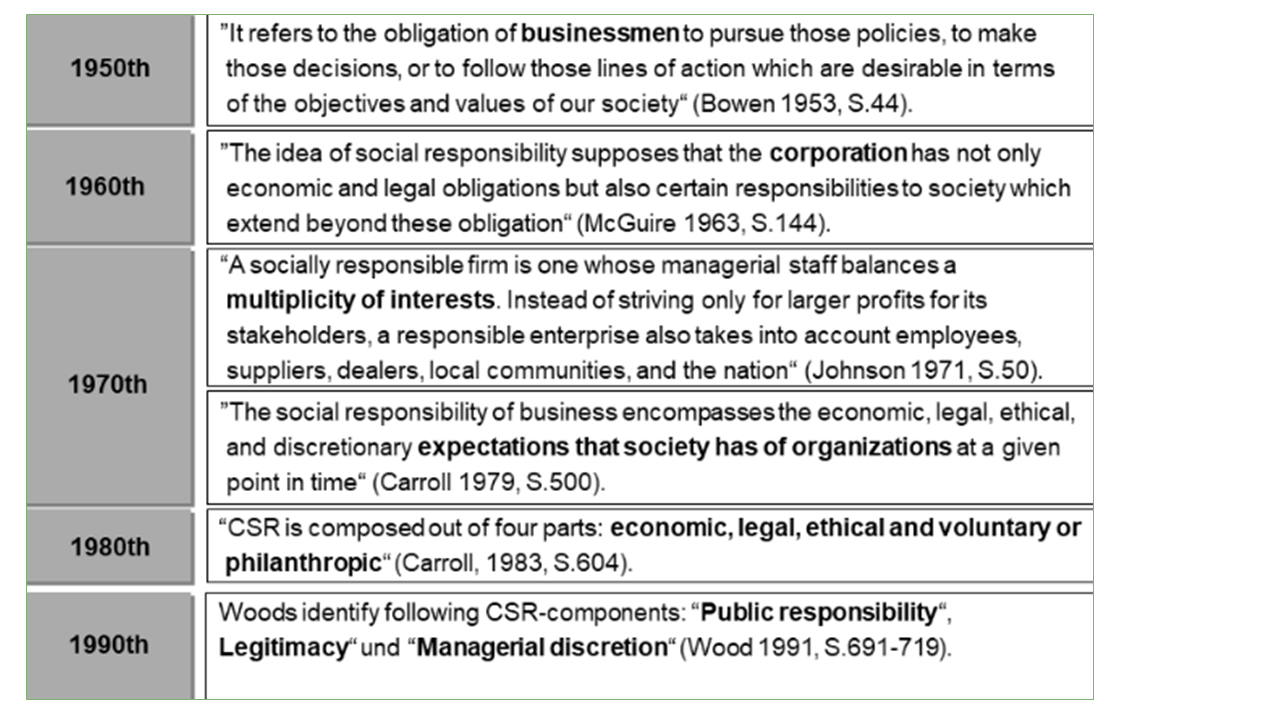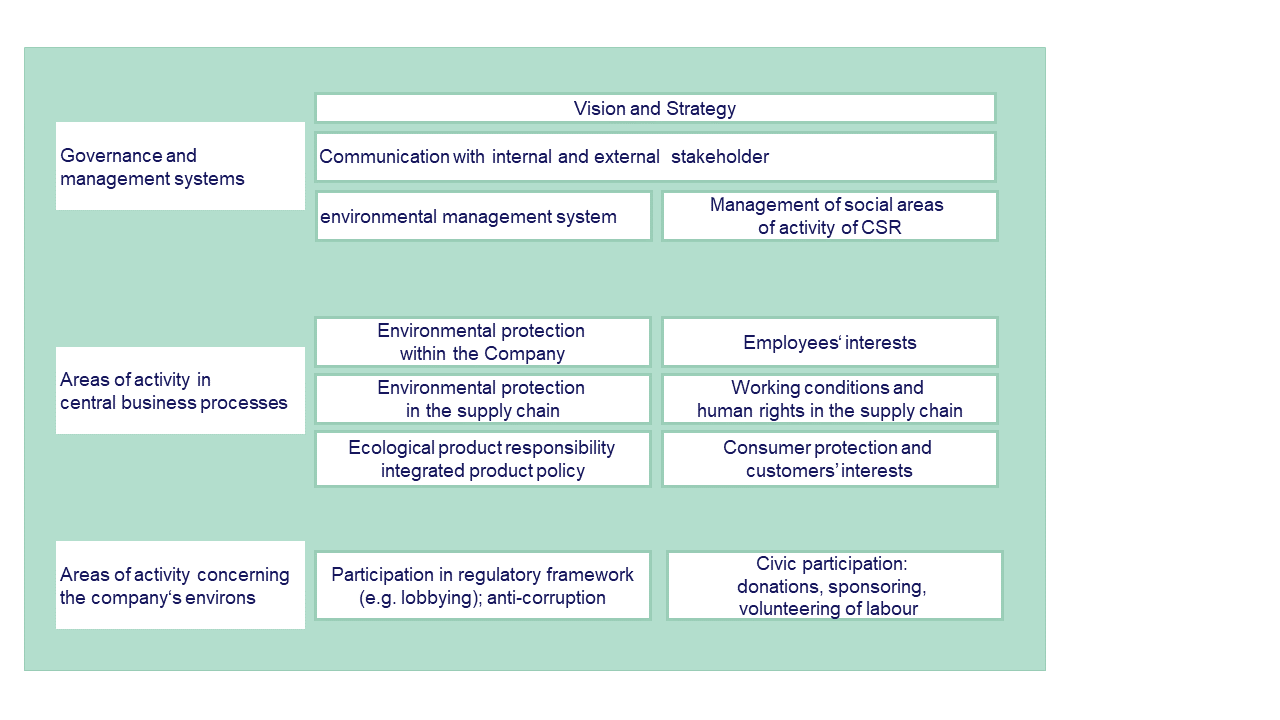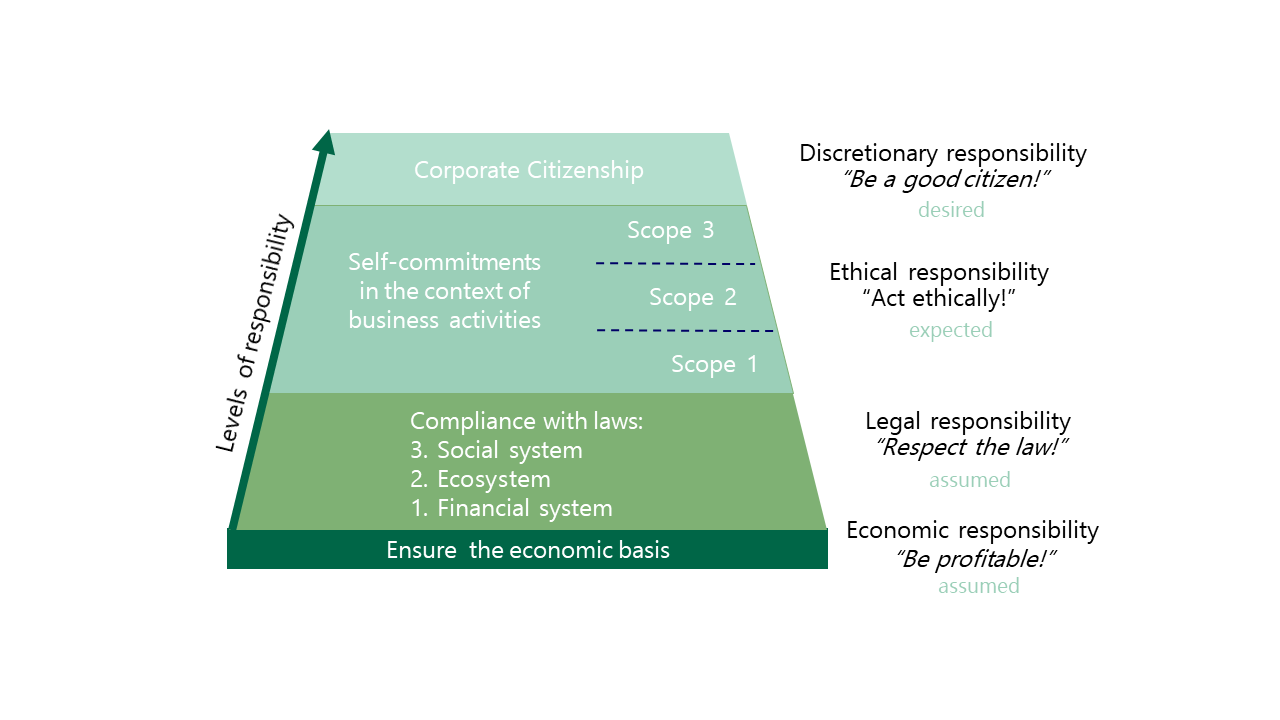Sustainability dimensions in goods movement
2. Social dimension
On the following page the social dimension of sustainability will be explained to you. After showing you the development of corporate social responsibility we are talking about the working conditions such as the dimensions and activities for companies.
Definitions of Corporate Social Responsibility (CSR)
According to Bowen (1953), the corporate social responsibility “refers to the obligation of businessmen to pursue those policies, to make those decisions, or to follow those lines of action which are desirable in terms of the objectives and values of our society.“
The European Commission (2001) states that Corporate social responsibility is basically a voluntary commitment by companies to work toward a better society and a cleaner environment.
CSR is closely linked to the already presented Ten principles of the United Nations Global Compact, which propose that companies should be required to make decisions not only on the basis of financial/economic factors, but also taking into account the social and environmental impact of their activities.
The following figure “Conceptual changes of Corporate Social Responsibility Concept over the years" shows the development of CSR from 1950 to 1990. Starting with a strong business and the obligation to follow the given policies, CSR has evolved and taken up more relevant criteria such as the expectations of the society, the multiplicity of interests, the public responsibility etc.

CSR for companies
CSR is a term used to describe what some consider to be a company's obligation to address the needs of all stakeholders in its business activities above and beyond legal requirements. The stakeholders of a company are all those who are influenced by, or can influence, a company’s decision and action. Stakeholders can be
- employees,
- customers,
- suppliers,
- community organizations,
- subsidiaries and affiliates,
- joint venture partners,
- local neighborhoods,
- investors, and shareholders (or a sole owner),
- financial and insurance institutions,
- and more...
Stakeholders are responsible for the value of companies. Over the last 20 years, their rates have become increasingly dependent on environmental and social standards, which are mostly formulated by environmental institutions.
Working conditions
Working conditions are an important pillar of the CSR standards, as companies could not operate successfully without their employees. For increasing the social sustainability of the companies, it is necessary to ensure better working conditions.
In the last years, the market conditions in logistics (Fast, Flexible, Cost-efficient and Heavy competitive pressure) lead to changing working conditions in industrialised countries:
- Long working times that are almost impossible to plan
- Outsourcing to third-party companies or bogus third-party companies
- Departure from normal working relationships
- Low pay
- Health and workplace conditions (heavy physical burden, working in noise and exhaust fumes, unhealthy way of life)
- Lack of balance between work and private life
- Job (dis)satisfaction
- Rising job requirements
Internal and external dimension of CSR in EU-green paper
In 2001, the European Commission defines the internal and external dimension of CSR for companies in their Green Paper: Promoting a European framework for Corporate Social Responsibility as follows:
Internal CSR dimension
- Human resource management
- Health and safety at work
- Adaptation to change
- Management of environmental impacts and natural resources
External CSR dimension
- Local communities
- Business partner, suppliers and consumers
- Human rights
- Global environmental concerns
Areas of impact of CSR
The following figure “Areas of impact of CSR” shows the influence of CSR on the company’s organization chart. CSR affects all areas of a company and covers all activities in the governance and management systems, all areas of activity in central business processes and all areas of activity concerning the company’s environment. A more sustainable vision and strategy impacts the whole company, while the communication with internal and external stakeholders, the environmental management system and the management of social areas of activity of CSR are changing the governance and management systems of a company. The environmental protection, improved working conditions or an ecological product responsibility are impacting the central business processes. The company's environment is changed by the participation in regulatory framework and the civic participation.
From compulsory to voluntary exercise: Levels of Corporate Social Responsibility
The following figure “Levels of Corporate Social Responsibility” shows the different levels of CSR, that can be reached. While the lower levels are compulsory, the upper levels are voluntary. The base is to ensure the profitability and to act responsible in terms of the well-being of the company. The next level is to ensure compliance with the law (legal responsibility). After those two compulsory levels, the next step to higher the level of CSR, the companies need to act ethically, which means that they can self-commit their business activities in terms of the three scopes which will be explained on the next page. The highest level of CSR is reached when there is really a corporate citizenship, which means that the company is acting like a good citizen.Competition
Sustainability reporting and labelling are becoming increasingly important in a competitive environment. Today, the topics that companies deal with are defined in a multi-stakeholder process. An in-depth look at the activities of companies shows the concentration of measures on win-win measures, i.e. economic-ecological efficiency.On the next page, you will find out more about the ecological dimension of the movement of goods.
Sources
Bowen, H. R. (1953): Social Responsibilities of the Businessman. New York, Harper and Brothers. Commission of the European Communities (Ed.) (2001).
Bundesministerium für Umwelt, Naturschutz und Reaktorsicherheit (BMU) (Ed.) (2006): Corporate social Responsibility Eine Orientierung aus Umweltsicht.
Carroll, A. B. (1979): "A Three-Dimensional Conceptual Model of Corporate Performance." Academy of Management Review 4(4): 497-505.
Carroll, A. B. (1983): "Corporate Social Responsibility: Will industry respond to cutbacks in social program funding?" Vital Speeches of the day 49: 604-608.
Carroll, A. & Buchholtz, A. (2003): Business & Society. Ethicx and Stakeholder Management. Ohio.
Drewes, P. (2012): Corporate Sustainability Management (CSM) in der Containerschifffahr. Harburger Berichte zur Verkehrsplanung und Logistik, Band 10, Schriftenreihe des Instituts für Verkehrsplanung und Logistik. Technische Universität Hamburg-Harburg. ISBN 978-3-86991-702-3
McGuire, J. W. (1963): Business & Society New York, McGraw-Hill
Wood, D. J. (1991): "Corporate Social Performance Revisited." Veröffentlichungsreihe der Abteilung Organisation und Technikgenesung des Forschungsschwerpunkts Technik Arbeit-Umwelt des Wissenschaftszentrums Berlin für Sozialforschung(FS II 91-101): 0-34.
